Since the 2017 tax reform bill capped state and local tax (SALT) deductions, legislators in high-tax states from New Jersey to Minnesota have ratcheted up rhetoric against supposed “moocher” states—states that critics claim do not carry their weight of the federal tax burden.REF They argue that an increased or unlimited SALT deduction is necessary to reduce perceived imbalances between states.REF Another common but dubious claim is that the SALT deduction improves the fairness of the tax code by mostly reducing the tax burden of individuals in high cost-of-living areas.REF
Prior to the Tax Cuts and Jobs Act of 2017 (TCJA), individual taxpayers who itemized their tax returns could deduct an unlimited amount of state and local taxes from their federal taxable income.REF TCJA placed a $10,000 limitation on SALT deductions, though this provision is scheduled to expire in 2025, along with other reforms to the individual side of the tax code.REF The Build Back Better Act, as passed by the House of Representatives, would raise the SALT deduction cap to $80,000 through 2030,REF a change that would benefit a small number of mostly high-income taxpayers.REF
There was and continues to be a sound rationale for capping (or eliminating) the SALT deduction. The deduction is unwarranted because residents should benefit from the state and local government services their taxes fund.REF Taxpayers cannot claim a deduction for private consumption, nor should they be able to deduct the cost of the services that they (or their elected representatives) choose to have provided by their state or local governments. Representative Dean Phillips (D–MN) inadvertently made this point while arguing for the SALT deduction: “Minnesota is a high-tax state and by investing in our communities we have made our state a national leader in health care provision, quality education, parks, safety, a strong economy, and so much more.”REF The notion that the SALT deduction is then necessary to level the playing field between taxpayers in high-tax states and low-tax states implies that state governments are poor stewards of taxpayer dollars. The idea of making tax burdens fairer across states confuses the issue because it implicitly suggests that states pay federal taxes, when, in fact, only people pay taxes.
The federal government’s expansion into roles and powers that the Constitution leaves to the purview of the states naturally leads to disagreements about who should fund those activities. The solution to such disagreements is not to change the tax code to bring about regional equity. Instead, lawmakers should devolve federal programs back to the states so that a state’s taxpayers are responsible for funding their own programs.
Putting the notion of true federalism aside, advocates of a higher or unlimited SALT cap most often rely on two arguments for the tax preference, the “moocher state” argument and the cost-of-living argument. This Backgrounder describes these two arguments for an expanded SALT deduction and explains why they have no merit.
The “Moocher State” Argument
The “moocher state” argument describes some states as net donors in the federal tax-and-spending system and others as net recipients—or, more bluntly, moochers. Proponents of this argument claim to want states’ balance of payments (outlays from the federal government to the state minus taxes and other payments to the federal government) to be more even. They claim that the states that have the most negative balance of payments (the donor states) are the high-tax states that benefit most from the SALT deduction.REF Therefore, some see expansion of the SALT deduction as a fix for this perceived imbalance.REF
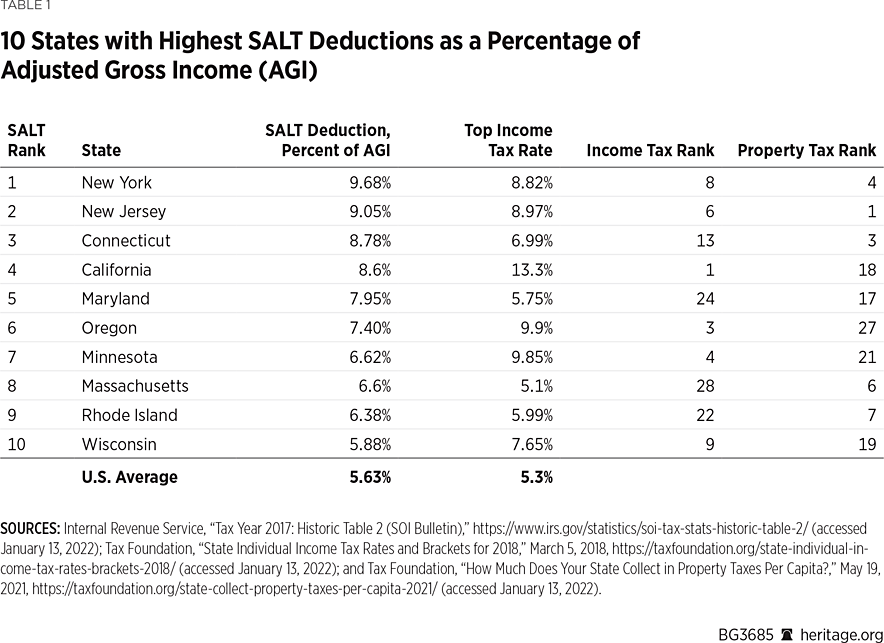
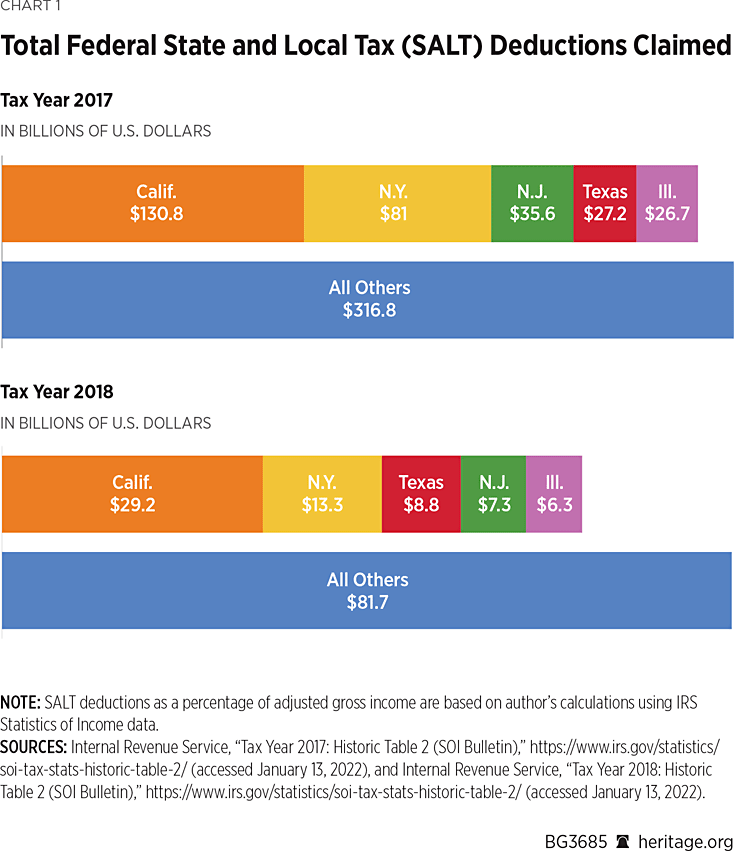
This argument is correct in one regard. The SALT deduction does provide disproportionate benefit to taxpayers in a few high-tax states. New York, New Jersey, Connecticut, and California all rank among the top states in income tax rates and property taxes per capita. In 2017, the last year before the SALT deduction was capped:
- The average individual federal taxpayer claimed SALT deductions equal to 5.6 percent of adjusted gross income (AGI);
- New York taxpayers claimed SALT deductions equal to 9.7 percent of AGI (highest of 50 states);
- New Jersey taxpayers claimed SALT deductions equal to 9.1 percent of AGI (second-highest);
- Connecticut taxpayers claimed SALT deductions equal to 8.8 percent of AGI (third-highest); and
- California taxpayers claimed SALT deductions equal to 8.6 percent (fourth-highest).REF
On the other hand, taxpayers in eight of the nine states with no individual income tax claimed SALT deductions of less than 3.1 percent of AGI, ranking between 40th and 50th among the 50 states.REF
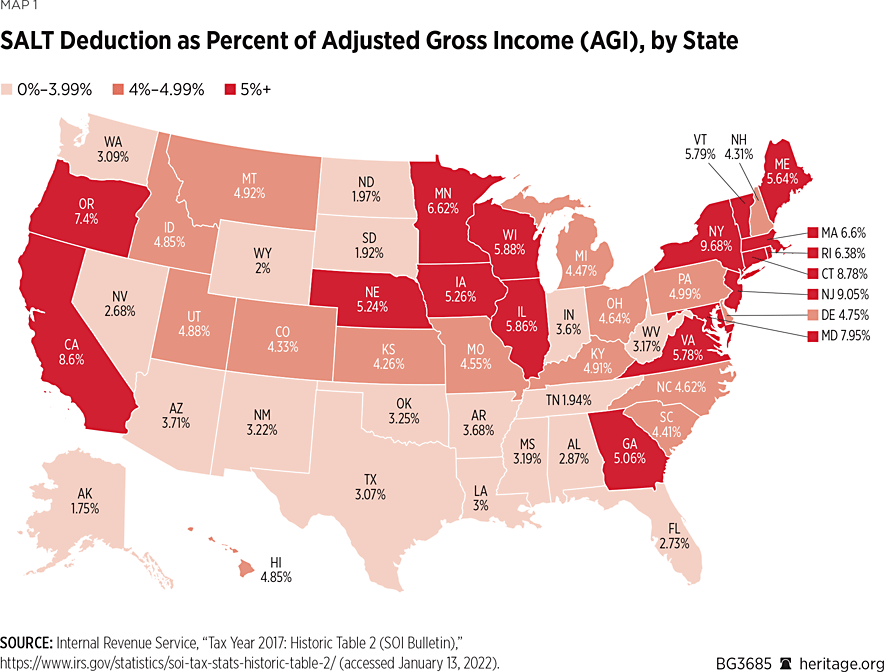
The Basis for the “Moocher State” Argument. Those making the “moocher state” argument often cite an annual report prepared by the Rockefeller Institute of Government.REF This report uses broad definitions of both revenues and expenditures to estimate states’ balance of payments. It seeks to assign or allocate every dollar of federal budget expenditures in the following categories to a recipient state:REF
- Wages to federal employees,
- Direct payments to individuals,
- Contracts for services and other procurement to the federal government, and
- Grants.REF
The analysis—partially funded by New York taxpayersREF—finds that “New York’s residents and businesses in 2019 sent $22.8 billion more to the federal government than they got back in return—a shortfall larger than that of the second and third-ranked state combined.” The report shows some other high-tax states—such as Connecticut, New Jersey, and Massachusetts—among the states with the most negative balance of payments, but overall correlation between per-capita balance of payments and levels of state and local tax deductions claimed is relatively weak.REF
Many of the factors that cause other states to receive a high, positive balance of payments from the federal government have nothing to do with the residents of those states freeloading off other states. The reality is far more nuanced than the notion that there are states that give and states that take.
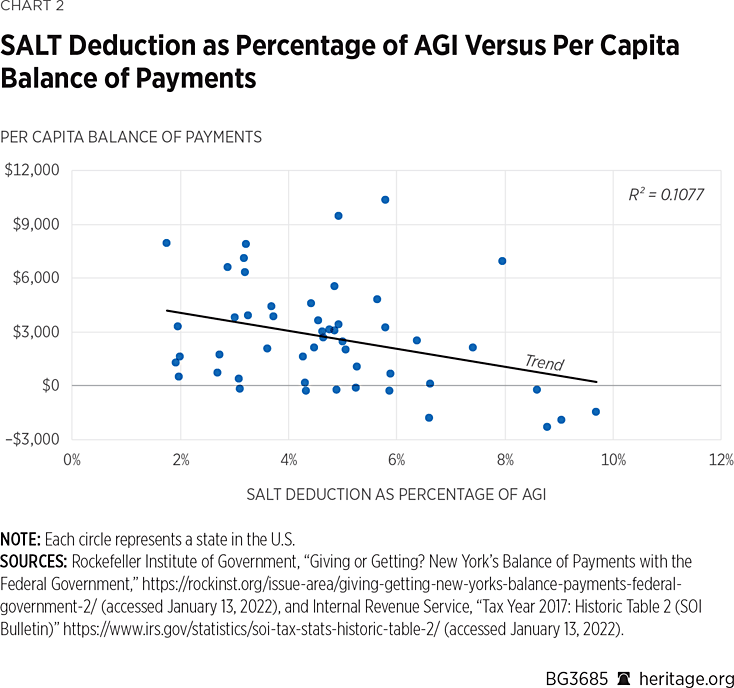
Federal Wages, Federal Contracts, and the Military. The Rockefeller Institute report finds that from 2015 to 2019, Virginia was the largest net recipient of federal dollars. The report’s methodology records all wages and contracts paid by the federal government as adding to a state’s balance of payments, so Virginia’s huge federal workforce (due to its proximity to the nation’s capital) causes the state to appear as a recipient of a disproportionate share of federal expenditures.REF Although the report omits Washington, DC, from its analysis, based on the report’s methodology, the District would undoubtedly rank as a bigger per-capita recipient of federal dollars than any U.S. state.REF
The largest federal employer, by far, is the military. According to the Rockefeller Institute report, over 38 percent of federal government wages are for the military.REF High levels of military wages contribute to some states with large military populations accumulating high, positive balances of payments, including Alaska (3rd), Hawaii (9th), and South Carolina (11th).REF Of course, military personnel support the defense of the whole nation, not just the states where they are stationed. The concentration of military forces in Hawaii and Alaska, for example, is strategically motivated.REF More servicemembers in a state certainly should not be construed as making it more of a moocher state.
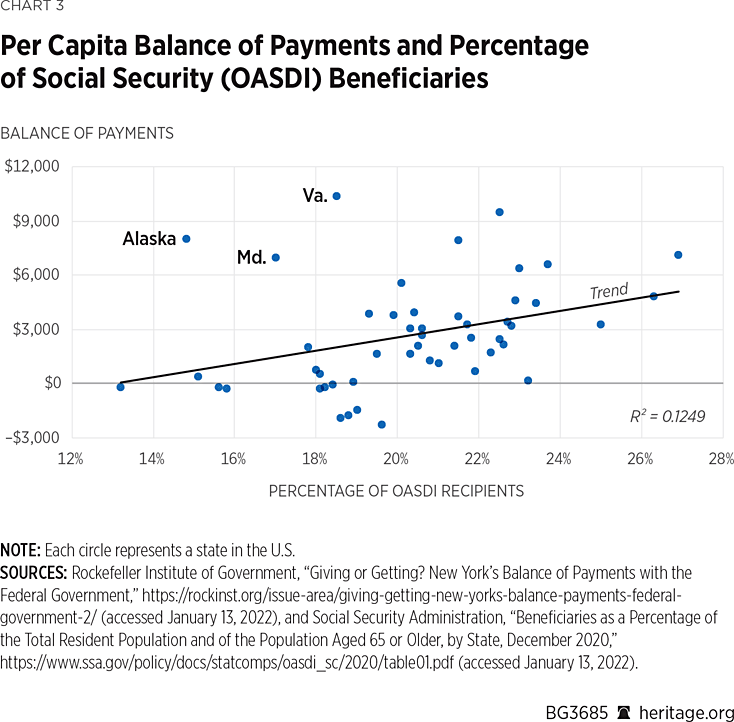
Social Security and Medicare Payments. A larger factor determining states’ balance of payments is the share of the state’s residents that receive benefits from the federal government’s two largest programs, Social Security and Medicare.REF Based on the Rockefeller Institute report, of the $2.56 trillion of federal direct payments to individuals in 2019, more than 70 percent were Social Security and Medicare outlays.REF Since Social Security and Medicare comprise a large share of federal spending, states with more elderly residents tend to appear as net recipients of federal funds in the Rockefeller Institute report.
West Virginia (26.9 percent), Maine (26.3 percent), Vermont (25.0 percent), and Alabama (23.7 percent) rank as having the most Social Security beneficiaries per capita.REF The Rockefeller Institute report ranks these states as having the 5th-, 10th-, 19th-, and 7th-highest per capita balance of payments, respectively.REF
Meanwhile, Utah (13.2 percent), Alaska (14.8 percent), Texas (15.1 percent), and California (15.6 percent) have the smallest relative shares of Social Security beneficiaries.REF The report ranks these younger states as having the 43rd-, 3rd-, 38th-, and 44th-highest balance of payments per capita.REF (Alaska’s large share of the armed services and federal research installations partially explains it being an outlier.)
The federal government does not pay Social Security and Medicare benefits to states; it pays these benefits to individuals based on their age and previous work history. If a California resident retires and moves to Maine, he receives the same benefits there that he would have in California. The fact that states such as Maine and West Virginia house a large share of retirees who are on Social Security makes those states appear as bigger net recipients, regardless of how much those retirees might have previously contributed to Social Security and federal income taxes.
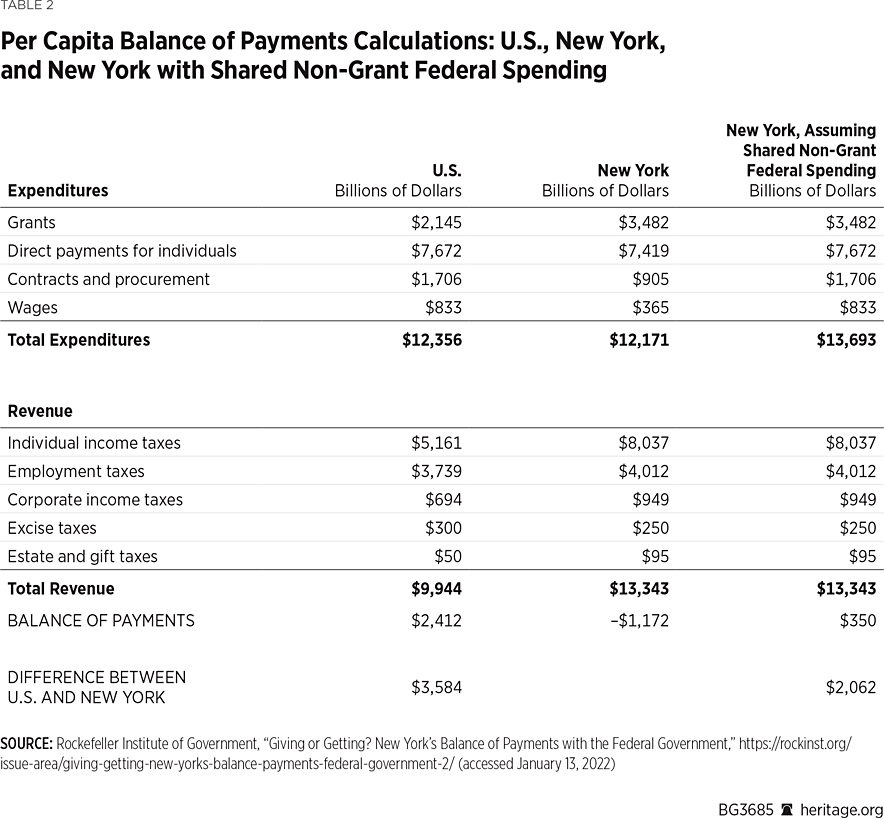
Grants. The category of federal expenditures where benefits are most often state-specific is grants.REF Federal grants include Medicaid services, transportation services, child nutrition programs, public housing and rental assistance, income security programs such as Temporary Assistance for Needy Families, and educational grants.REF The Rockefeller Institute estimates that in 2019, New York received the fourth-highest level of grants per capita, at $3,482 compared to a U.S. average of $2,145. This hardly suggests that federal outlays shortchange New York.REF Other high-tax states that benefit most from the SALT deduction receive federal grants at near the same rate or higher than the U.S. average, as shown in Chart 4.
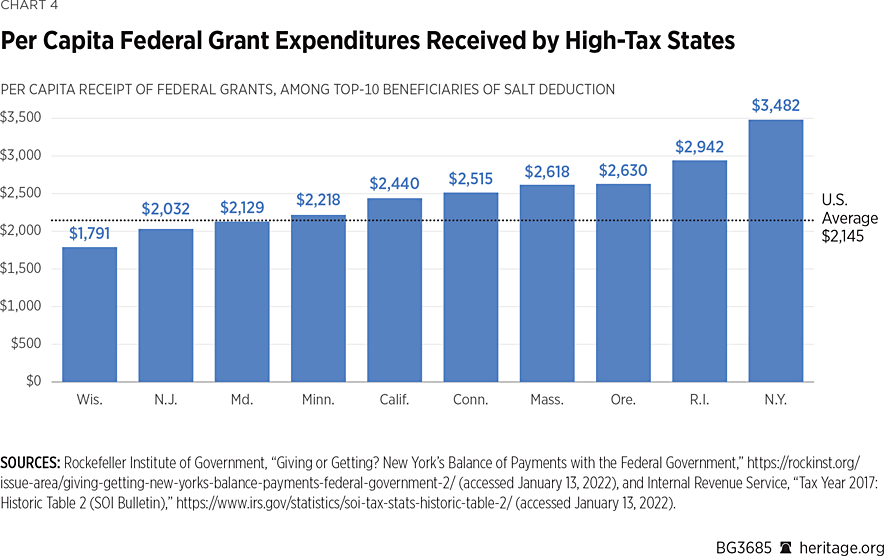
The Inescapable Reality of a Highly Progressive Federal Tax Code. People in states that pay more federal taxes per capita do claim SALT deductions at a somewhat higher rate, though the amount of SALT deductions does not cause such states to pay more federal taxes (technically the opposite is true). The key factor is the composition of the state, namely its concentration of high-income taxpayers. Because the SALT deduction disproportionately benefits the wealthy, states with more high-income residents also claim more SALT deductions. At the same time, states with more high-income residents also pay more federal taxes per capita.REF
New York and other high-income states in the Northeast do tend to pay more federal taxes per capita—but not because they have high state and local taxes. They pay more federal taxes because they have a larger share of high-income individuals. This, of course, is the nature of a progressive tax system. Individuals and groups with higher incomes pay more in taxes not by accident but by design. The U.S. federal tax system is highly progressive. According to Congressional Budget Office data, the top 1 percent of taxpayers pay an average federal tax rate of 30 percent, while the poorest 20 percent of taxpayers pay an average federal tax rate of less than 0.1 percent.REF
The amount of federal income taxes paid by states (per filing) does not increase with the state’s top statutory income tax rate. For example, the nine states with no income tax (on wages) would benefit least from a higher SALT deduction, yet they rank toward the top in federal income taxes per tax filing. Six of the no-income-tax states rank in the top 15 of federal income taxes per filing, and all nine rank in the top 30.REF Since high-tax states do not generally pay more in federal taxes than low-tax states do, the case for the federal SALT deduction as a fix for “moocher states” is demonstrably false.
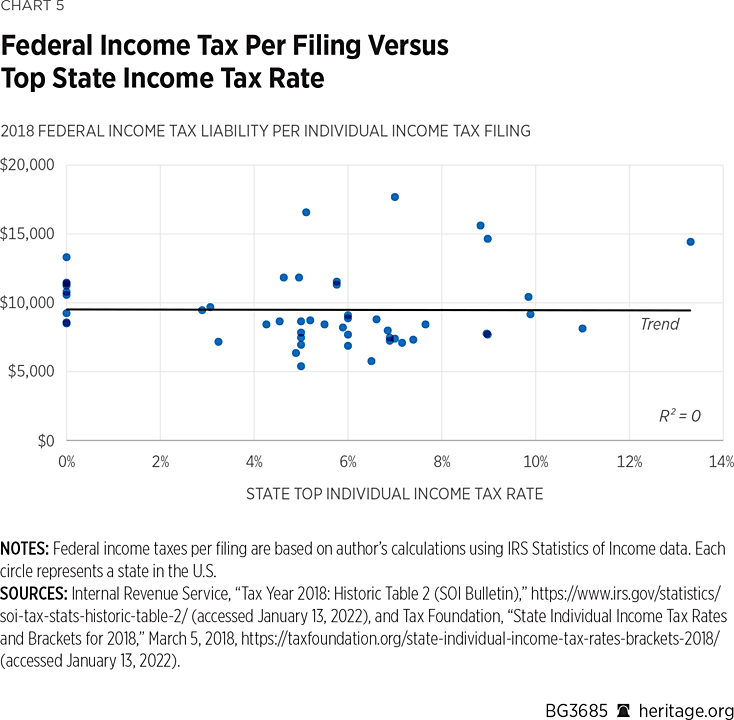
If one aims to equalize the average federal taxes paid by residents of different states, changing the SALT deduction would not be a particularly good way to do so. Any other features of the tax code that disproportionately affect the wealthy could be changed instead. For example, the alternative minimum tax (AMT) mostly hits individual taxpayers with incomes greater than $200,000. A state’s AMT paid as a percentage of AGI is more strongly correlated with federal taxes paid per filing (or balance of payments) than the SALT deduction is.REF Eliminating the AMT would reduce disparities in the total taxes per filer across states, and it would simplify the tax code without giving special advantages to states adopting particular tax policies.
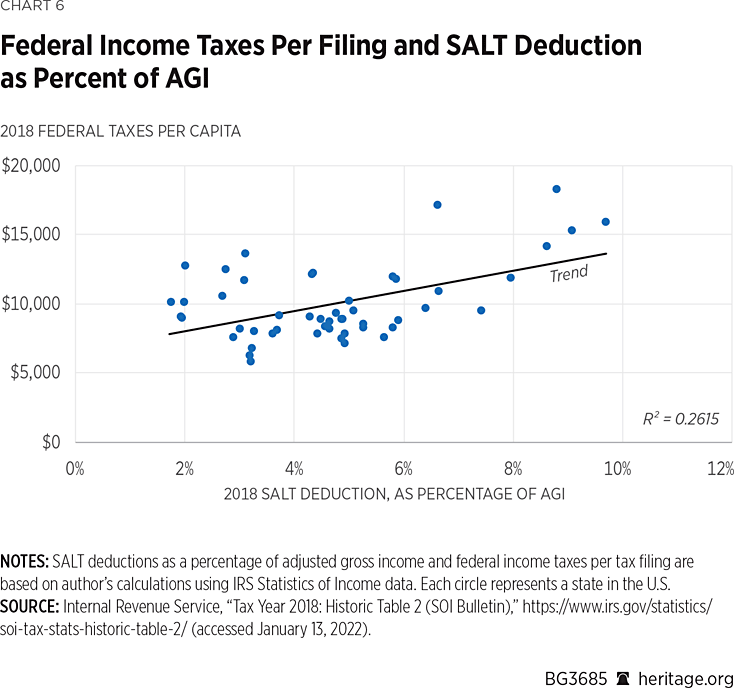
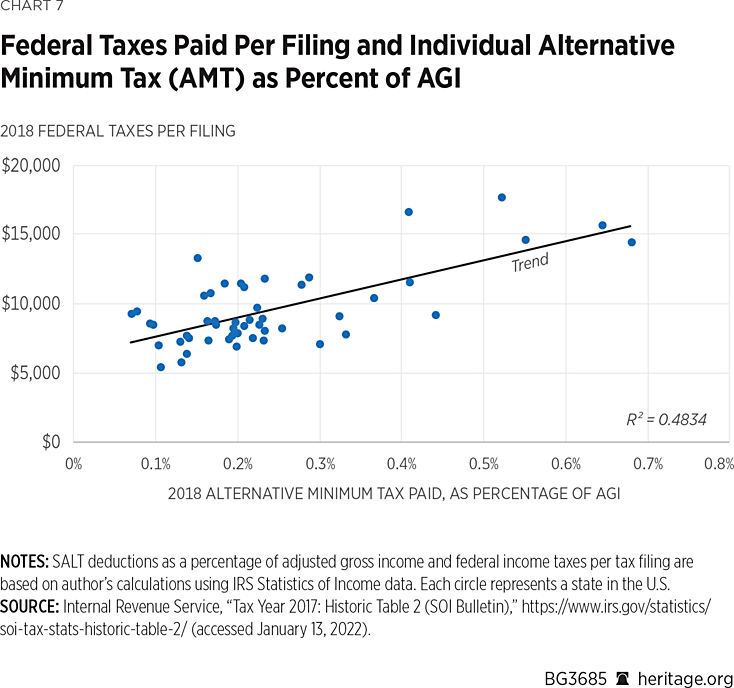
The Flawed Cost-of-Living Argument
The other common indirect argument used to justify the SALT deduction is that the deduction accounts for differences in cost of living. One’s paycheck does not go as far in New York City or the California coast as in the rest of the country, so some argue that taxpayers there end up paying more taxes than their cost-adjusted income warrants. The SALT deduction, they argue, acts like a cost-of-living-adjustment, because taxpayers in California and New York disproportionately benefit from the SALT deduction.REF
State and Local Taxes, Public Amenities, and Cost-of-Living Differences. It is, of course, true that the cost of living is significantly higher in certain parts of the country. Cost-of-living differences in some cases reflect differences in tax rates, so, unsurprisingly, there is some correlation between an area’s price levels and the amount of SALT deductions. Higher state taxes, of course, indicate higher levels of state government services. To the extent state taxes cause cost-of-living differences, the taxpayers in more expensive states already receive the benefits of those services (assuming a well-run state government). A federal SALT deduction in that case simply rewards consumption of state-government-provided services over the consumption of private-sector goods and services. Here, the SALT deduction does not fix a disparity in the tax code; it creates one.
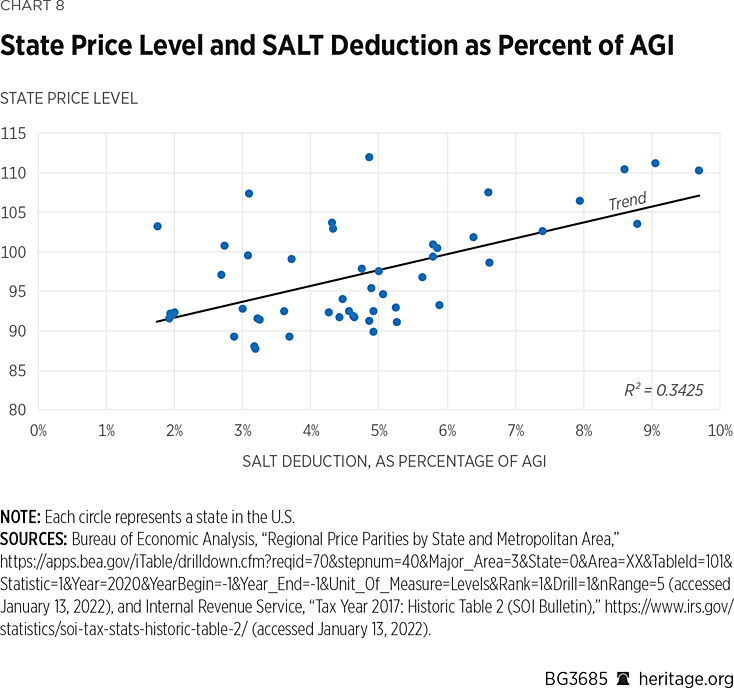
Natural Amenities and Cost-of-Living Differences. Even though taxes can directly cause higher prices in an area, the connection between high taxes and high cost of living goes only so far. For example, housing—by far the most important factor in cost of living—is generally more expensive in the Mountain West region than in states bordering the Great Lakes, even though SALT-deductible taxes tend to be lower in the Mountain West.REF The median housing value averaged about $192,000 between 2015 and 2019 in the eight states bordering the Great Lakes—Illinois, Indiana, Michigan, Minnesota, New York, Ohio, Pennsylvania, and WisconsinREF (about $175,000 if New York is excluded). The eight states in the Mountain West region—Arizona, Colorado, Idaho, Montana, Nevada, New Mexico, Utah, and Wyoming—averaged a $244,000 median home value between 2015 and 2019.REF While the Mountain West states averaged more than 30 percent higher housing values, in 2017 they averaged more than 30 percent less in SALT deductions (3.82 percent versus 5.72 percent).REF
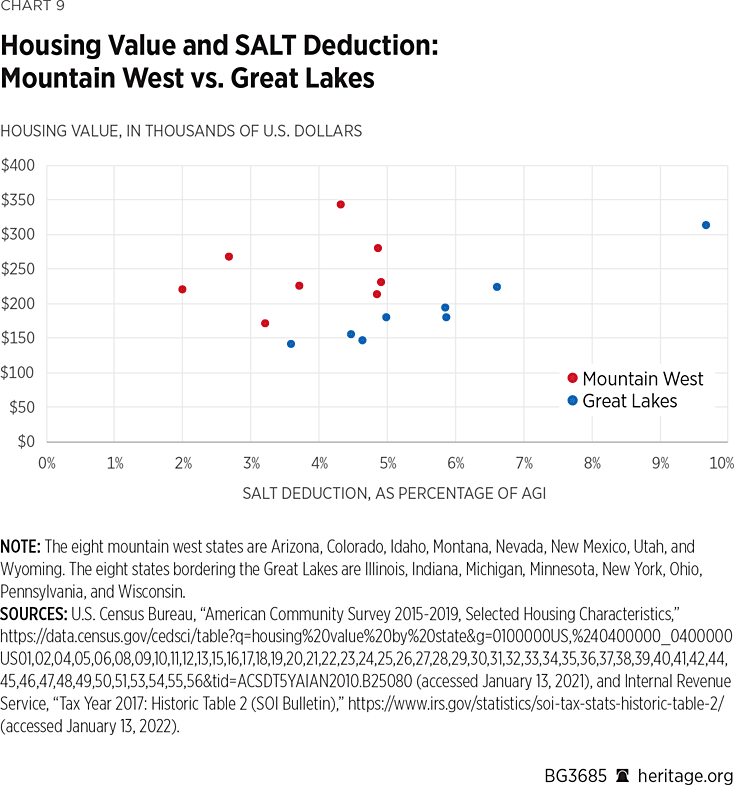
Differences in natural amenities—and perhaps to a lesser extent differences in weather—are likely part of the reason for the higher cost of living in the Mountain West than in states bordering the Great Lakes.REF On the one hand, homebuyers, on average, are willing to pay more to have scenic natural views and access to outdoor activities that the Mountain West states offer. This tends to drive up housing demand relative to supply, resulting in higher housing prices. At the same time, there are constraints on housing supply in the Mountain West, including difficulties of building in mountainous terrain and the vast swaths of land owned by the federal government.REF
The SALT Deduction: A Bad Proxy for Cost of Living. If the SALT deduction were expanded as a quasi-cost-of-living adjustment, the federal tax code would exacerbate such differences between Mountain West states and states bordering the Great Lakes. Residents of the Great Lakes states would benefit more from the SALT deduction despite living in a more affordable region.
Average cost of living also varies wildly within states, so many residents of high cost-of-living states face low prices in the cities or towns where they live.REF Likewise, some residents of low cost-of-living states may face high local prices. Housing in Miami, Florida, for example, is almost twice as expensive as in Buffalo, New York.REF However, a Buffalonian could deduct more state and local taxes than a Miamian with the same income.REF
The point here is not that there is a negative relationship between state taxes and cost of living. The point is that the SALT deduction is a very blunt tool to adjust for cost-of-living differences. Furthermore, to the extent the causation is reversed (a higher SALT deduction leading to higher cost of living), it indicates that the high-tax-state residents already receive the corresponding benefit of higher state government spending and should not require an additional federal tax deduction.
Would a Cost-of-Living Adjustment Be a Good Thing? As alluded to above, a portion of cost-of-living differences between areas reflects differences in amenities, whether those are government-provided or natural amenities. Part of the reason that it is more expensive to buy or rent a home in Hawaii or California is that many Americans prefer warm weather and sandy beaches, and only a small portion of the United States (by area) offers those amenities. Some will pay a premium to live near the beach, while others might opt for a lower cost of living with fewer amenities.REF The tax code should not give a special preference to taxpayers that pay more to live in an area with abundant natural amenities.
Differences in cost of living are a valuable market signal, so even if the SALT deduction were a perfect cost-of-living adjustment, it would still be undesirable. A high cost of living in an area indicates that the supply of housing (or some other product) is struggling to meet demand.REF When potential homebuyers or renters see the high cost of living of an area, some will be dissuaded from moving there and further straining the area’s limited resources. If the tax code provides a tax break for living in high cost-of-living areas, this pushes more people into those areas and puts more strain on stretched housing markets, only further driving up prices.
Recommendations to Reduce Regional Bias in the Federal Budget
Instead of raising the SALT deduction cap, Congress should consider the following solutions, which would reduce any regional bias in the federal budget:
- Eliminate the SALT deduction and other unwarranted tax preferences. The SALT deduction is a subsidy for high-tax states and states that rely more heavily on the income tax.REF Ending the SALT deduction would put pressure on states to reduce spending and taxes. This would help ensure that state governments only spend on programs and projects when the benefits to their residents outweigh the true costs. The SALT deduction should be eliminated altogether, along with the wide range of energy tax credits, housing credits, and place-based credits such as opportunity zones.REF Most tax preferences in the tax code are economically unwarranted.REF
- Reject future state bailouts. The 2021 American Rescue Plan included over $300 billion of funding for state and local governments, ostensibly to allow them to respond to the COVID-19 pandemic, despite little actual drop in state tax revenue during the pandemic.REF The formula used to determine each state’s allocation was based on its unemployment rate during the fourth quarter of 2020.REF This had the effect of rewarding states for choosing to prolong economic lockdowns and extend generous unemployment benefits. The federal government should not protect state and local governments from their own fiscal and economic decisions.REF
- Reduce non-defense federal spending and devolve more governance to the states. The federal government should have little power to redistribute resources in the first place, but as the federal government has encroached more and more on states’ rights, federal government redistribution has become commonplace.REF Prior to World War II, state and local governments accounted for most government spending in the United States.REF Until the expansion of the welfare state that took place under President Lyndon Johnson’s Great Society, most federal spending was defense related.REF Moving back toward a limited scope for the federal government would reduce redistribution among individuals in different states, which would in turn reduce disagreements among states about the distributive impacts of federal taxation and spending.
Conclusion
The fact that certain high-tax states stand to benefit disproportionately from a SALT deduction expansion has led to region-based justifications for the deduction. Region-based justifications for the SALT deduction fall apart on closer inspection. The United States does not break down neatly into donor states and recipient states. Americans in high-tax states do not carry the federal fiscal burdens of other Americans. High-income individuals do pay a disproportionate share of the federal tax burden and claim more SALT deductions—but this is true regardless of whether they live in high- or low-tax states, and it is an intended result of a highly progressive federal tax code.
High state taxes (and regulations) can directly lead to higher cost of living, though this does not justify a SALT deduction, because state taxes fund public amenities that are meant to benefit a state’s residents. If certain states want to provide tax relief to high-income residents, they should do so by making their own tax codes less progressive instead of pushing those burdens onto other federal taxpayers.
In other cases, differences in natural amenities drive cost-of-living differences. However, supply-and-demand forces dictate such cost-of-living differences, so it is unclear why the tax code should be used to alleviate these differences. With no valid justification for its existence, the SALT deduction is a solution in search of a problem.
Preston Brashers is Senior Analyst for Tax Policy in the Grover M. Hermann Center for the Federal Budget, of the Institute for Economic Freedom, at The Heritage Foundation.



